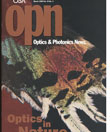
March 1999 Issue
- On the Solar Spectrum and the Color Sensitivity of the Eye
- Green Flashes and Mirages
- Cirrus Clouds and Halos: A Closer Look
- Glittering Light on Water
- Shining Armor: Structural Colors in Insects
- Eye Optics of Marine Mammals
- Comp.risks
- Geometric-optical Rays, Poynting's Vector, and Field Momenta
- Wide-range TV Zoom Lens
- Making Leeuwenhoek Proud: Building Simple Microscopes
- Browse all Issues
Feature Articles
On the Solar Spectrum and the Color Sensitivity of the Eye
The solar spectrum peaks in the green part of the spectrum, right? Wrong! It only peaks in the green when plotted in wavelength units. It peaks in the near-infrared when plotted in frequency units.
by David K. Lynch, Bernard H. SofferGreen Flashes and Mirages
Green flashes have been described by first-hand observers for hundreds of years. But incorrect interpretations by scientists have perpetuated misunderstandings about their true nature. This article traces that history and explains this mirage-like phenomenon.
by Andrew T. YoungCirrus Clouds and Halos: A Closer Look
What's the connection between cirrus clouds, halos, coronas, and arcs/circles? It appears to be more complex than previously thought, and may depend in large part on the geographic locations of the clouds.
by Kenneth SassenGlittering Light on Water
Light that glitters off a lake at sunset is more than just a beautiful picture, it tells a story of wind direction, air temperature, and more.
by Joseph A. ShawShining Armor: Structural Colors in Insects
The wings and cuticles of insects have much to teach us in areas such as thin films, lattice structures, iridescence, and polarization.
by Helen GhiradellaEye Optics of Marine Mammals
Marine mammals are unique in their need to see equally clear both above and under water. Three theories of how their eyes adapt to these different environments are discussed.
by Heather M. ZornComp.risks
Since computers are becoming so omnipresent in our daily lives, I thought this month it might be interesting to take a look at some of the more risky and less desirable aspects of the computer. A good place to look for information on this topic is the USEnet newsgroup comp. risks, which is moderated by one of the leaders in this area.
by Bob JopsonGeometric-optical Rays, Poynting's Vector, and Field Momenta
In isotropic media, the rays of geometrical optics are usually obtained from the surfaces of constant phase (i.e., wavefronts) by drawing normals to these surfaces at various points of interest. It is also possible to find the rays from the eikonal equation, which is derived from Maxwell's equations in the limit when the wavelength λ of the light is vanishingly small. Both methods provide a fairly accurate picture of beam propagation and electromagnetic energy transport in situations where the concepts of geometrical optics and ray-tracing are applicable. The ray artifact, however, breaks down near caustics and focal points and in the vicinity of sharp boundaries, where diffraction effects and the vectorial nature of the field can no longer be ignored.
by Masud MansuripurWide-range TV Zoom Lens
Zoom lenses for T V cameras are required to have a large zoom range while maintaining high image quality at a large aperture. These requirements are similar to those for consumer video camera objectives, although the latter tend to sacrifice image quality to attain compactness and low-cost. Since cost, size, and weight are less important than image quality and zoom range, TV zooms can be substantially larger and often incorporate one or more abnormal dispersion glass elements to reduce secondary color.
by J. Brian CaldwellMaking Leeuwenhoek Proud: Building Simple Microscopes
Antony van Leeuwenhoek (1632-1723) of Delft, The Netherlands, advanced the science of microscopy sometime before 1668 with his observations through a simple glass bead. Although Leeuwenhoek did not invent the microscope—compound microscopes had been in use nearly 40 years before he was born—his relatively crude, hand-built creations were an order of magnitude better than the best microscopes available at the time. Leeuwenhoek was able to describe microscopic objects, such as blood platelets and "animacules," that had never been resolved using multi-lensed instruments, and he achieved magnifications of over 200 using a single, simple lens.
by James A. Mahaffey
![Infinity Mirrored Room– Brilliance of the Souls 2014 by artist Yayoi Kusama. [© YAYOI KUSAMA]](https://opnmedia.blob.core.windows.net/$web/opn/media/images/articles/2024/0724/departments/202407-cover-web.jpg?ext=.jpg)
![An experimental scheme demonstrated by researchers at Princeton and Yale universities, USA, can convert physical noise into errors that can be corrected more easily. [F. Wojciechowski, Princeton University]](https://opnmedia.blob.core.windows.net/$web/opn/media/images/articles/2024/0624/departments/202406-cover-web.jpg?ext=.jpg)
